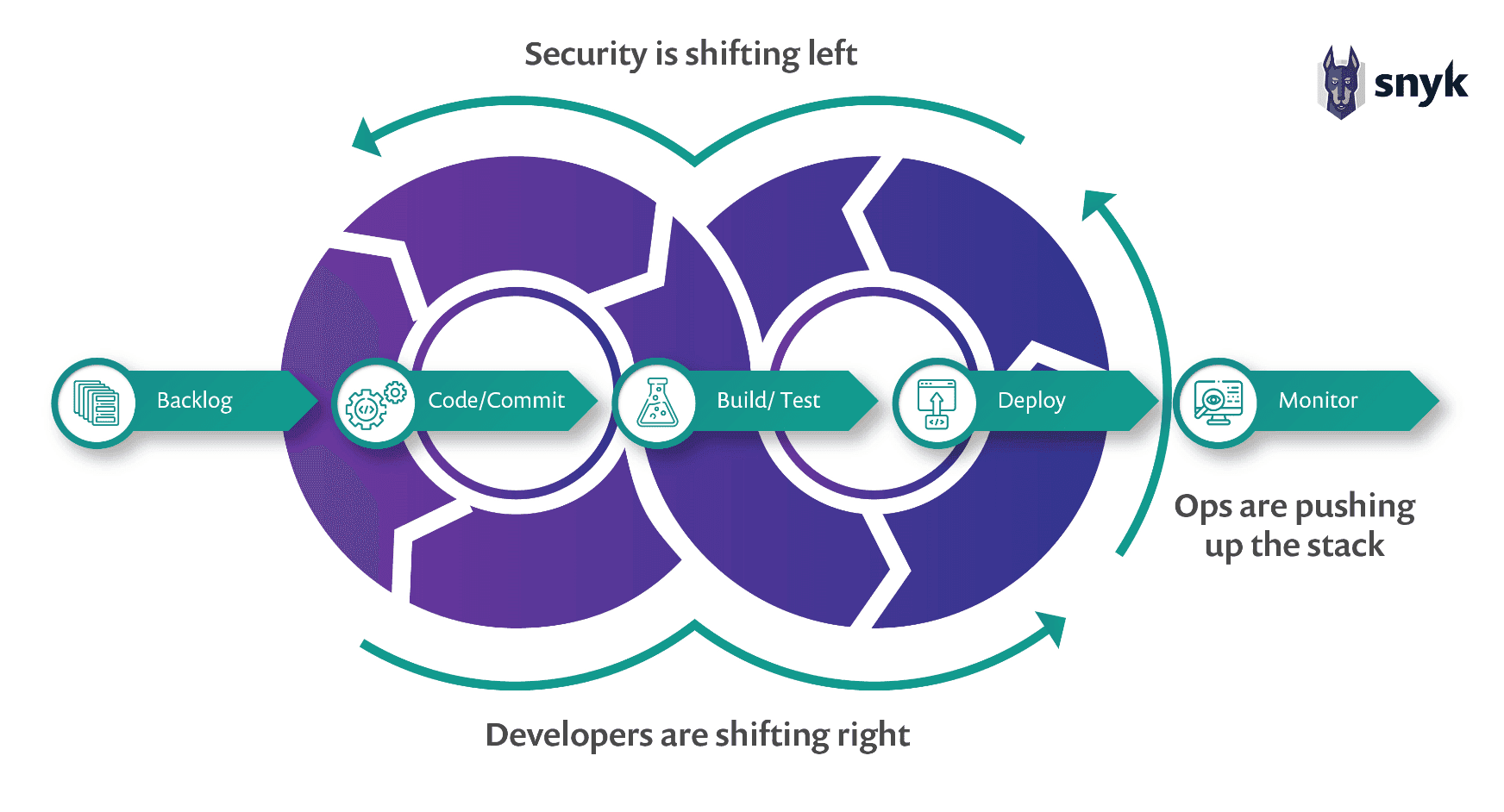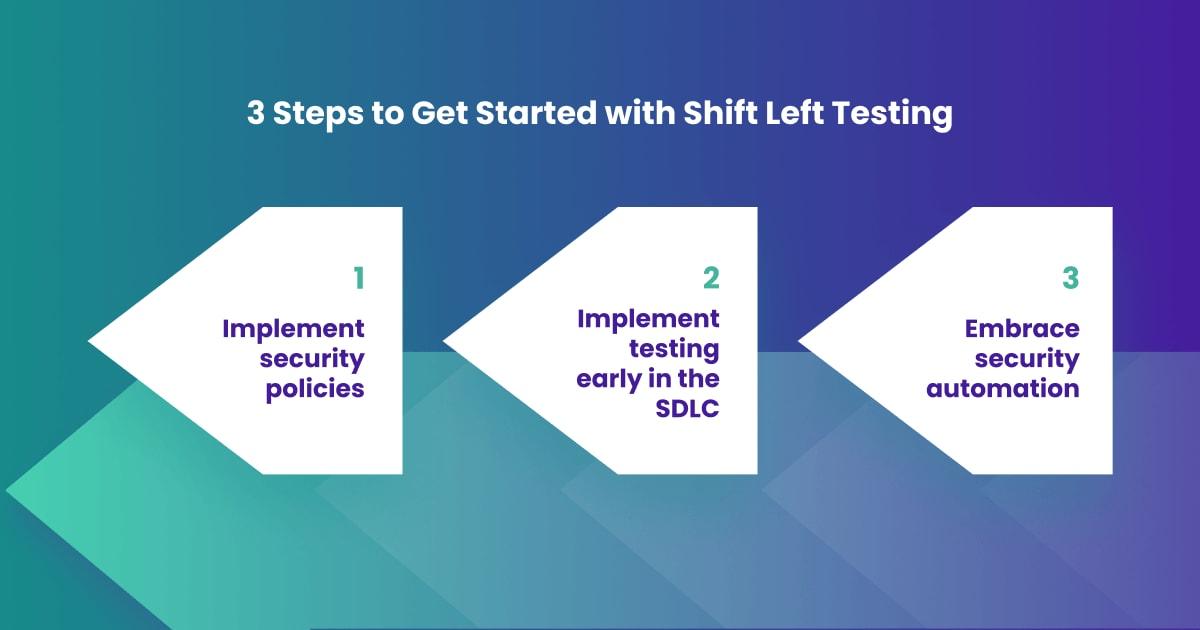The Basics of Getting Started with Shift Left Testing
Modernising your AppSec testing with shift-left philosophy
Shift left testing explained
What is shift left testing?
Shift left testing integrates software testing practices, including security, as early as possible in the software development lifecycle (SDLC). This means that development and operations teams are enabled through processes and tooling to share in the responsibility of delivering secure, high-quality software. Shift left testing and shift left tools help organizations release software more often by preventing common bugs and security issue bottlenecks.
Looking at the traditional continuous integration / continuous delivery (CI/CD) pipeline, testing is typically the fourth step in an eight step cycle. However, shift left testing integrates many aspects of testing into the Build and Code phases, literally shifting security and bug detection to the left.

How to shift security left in agile development
In typical cloud environments, software development tends to follow the agile methodology, where shift left testing fits nicely. Feature iteration happens quickly in agile development, typically in small code increments. As a consequence, the cadence of software deployment tends to be fast. Maintaining a high deployment velocity means that testing tools and objectives have to be adaptable to a dynamic and rapidly changing environment.
Shift left testing fits nicely within the Agile methodology.
Some organizations like to push shift left testing further toward the coding phase with test-driven development. By first writing the tests for the piece of code you want to develop, test-driven development helps you immediately validate code and prevent bugs. Similarly, organizations can push security testing left to prevent security issues as well. Application security tools should be proactive and should be able to cover the entire secure software development life cycle (SDLC) end to end.
In addition, shift-left security tools that proactively scan throughout the SDLC are better adapted for the multi-cloud environments often seen in larger organizations. The combination of private, public, and hybrid cloud platforms introduces new complexity. While organizations turn to multi-cloud seeking the benefits of flexibility and scalability, these benefits present significant security challenges. By adopting integrated security automation early in the process, with IaC scanning for example, development and security teams can better adapt to multi-cloud challenges.
Another way of pushing testing further left includes the use of static analysis solutions, such as Static Application Security Testing (SAST) tools. A SAST tool helps to identify problems with parameter types or incorrect usage of interfaces. Some SAST scanners show your mistakes while coding.
Get started in capture the flag
Learn how to solve capture the flag challenges by watching our virtual 101 workshop on demand.
How to get started with shifting left security testing
Shift left testing looks different in every organization. Variables like organization size, number of security personnel, current processes, and product risk exposure will influence how each team approaches this shift. However, the following steps will help you make a terrific start.

Step 1 - Implement security policies
Security policies are a good first step for shift left testing. Policies can automatically and consistently set boundaries before work begins, delivering critical information for efficient development processes, including security.
Agreement on coding standards should be a part of your security policy. These standards define the languages and configurations your team will use in particular situations. All developers must be on the same page. It helps them to review code quicker but also guarantees a higher quality of code. These policies should decrease the number of bugs following best practices help developers avoid bad or insecure code.
Step 2 - Implement testing early in the SDLC
As your developers gain awareness around secure coding practices, it’s wise to reexamine your SDLC. Understanding your current practices will help identify small steps you can take to place testing earlier. Additionally, you can find out which tools might be relevant for your codebase.
A possible strategy is to adopt the agile SDLC, which works with small code increments. Next, each sprint includes a development and testing phase. This makes sure that every small feature gets covered with relevant tests.
For some organizations, it’s not possible to make a drastic switch toward shift left testing. Therefore, the development team can agree on writing unit tests for each feature they develop.
Step 3 - Embrace security automation
Shift left testing means scanning for security issues more frequently, so your development team should embrace security automation tools. Security automation uses software-based processes to programmatically detect, investigate, and fix external threats to applications and systems. As such, automation speeds up the development life cycle and allows you to reduce the time to market.
Security automation speeds up the development life cycle and reduces time to market.
For example, security gating on pull requests is an early adoption method for establishing automated security. Often used as the backbone of Git-based development workflows, pull requests provide an easy collaboration point within applications as developers commit and merge changes into code repositories. Automation tools can test pull requests for security issues and license issues before code is merged.
Shifting left is a culture shift, not just new tools
Security and testing solutions can be critical to support shift left testing, but tooling is only one element in a much larger equation. Shift left testing also involves a significant culture shift. Achieving success also includes moving responsibilities from classic IT functions toward development teams, with the intention of speeding up the feedback loop. Because shift left testing involves changing the expected responsibilities for development, operations, and security teams in agile ways, simply implementing new tools won’t solve the problem.
Shift left testing involves changing the expected responsibilities for development, operations, and security teams in agile ways.
For example, a recent ESG study found that developers are being given more responsibility for testing applications for security issues without receiving proper training. While most organizations require security training, 35% of the respondents in the survey claimed that less than half of their development teams actually participate in formal training. Such failures in support culture offset any investments in security tooling. If developers don’t care to learn new testing methods, new security practices will fall apart. Security training that illustrates downstream time savings and easy-to-use, integrated tooling can often motivate developers to care more about new security responsibilities.
A shift left testing culture aims to build empathy and common goals among various disciplines within the organization. Development, operations, and security need to work more collaboratively and share responsibilities to distribute testing workloads among them. Some analysts refer to this culture as DevSecOps.
Shift left testing
By running the four tests outlined below, developers can begin shifting testing to the left. Each represents a minimal commitment while reducing friction within the security and quality assurance phases of software development.
Unit testing: Unit tests verify the performance of a single method, function, or class. Typically, you run them on the smallest testable unit of software, such as procedures, interfaces, or classes. Once a unit test is performed, it’s safe to integrate the unit into the larger codebase. When the unit test fails to return the correct value when fed input, it is marked as a failure, and the code is unfit for further use.
Basic functionality testing: Functionality tests evaluate whether all aspects of the code work properly, rather than focusing on the single output examined in unit tests. For example, is the application displaying correctly? Does the application work outside of development environments? Can users submit data without crashing the application? Is the called API supporting each feature? By performing these tests, users can save downstream time in QA or security.
Code review: Code review accelerates the coding process through a peer review for verification. Many developers overlook errors in their own code, but an impartial co-worker can often spot inconsistencies. A quick, second layer of manual verification can go a long way in cleaning up source code. It’s always a good idea to check for security issues in code that you review.
Static code analysis: Static code analysis uses automated tools to scan for errors in code without executing it. These tests examine code structure and ensure that the code meets standard criteria. A static analysis scans the code for the following issues:
Commonly identified security vulnerabilities (SAST)
Programming errors
Standard code violations
Syntax errors or anomalies
Undefined values
Static code analysis tools vary, but solutions should scan all untested code in a project before it moves to production. A static code analyzer checks code against a set of predefined standards and rules to determine if the code complies with them. This scanning helps to ensure that known security issues don’t impede the CI/CD pipeline at the security stage.
Importance of shift left security
Shift left security allows security to keep pace with agile development methodologies, while managing new risks introduced by cloud technologies.
Agile methodology and DevOps practices change how software is developed and delivered, accelerating the cycle from writing code to delivering customer value to learning from the market and adapting. Empowered development teams ship software continuously and faster than ever, making technology and implementation decisions autonomously and without intermediaries.
As the rest of the organization has evolved, security teams are faced with greater demands and often become more of a bottleneck. Legacy application security tools and practices, designed for the slower-paced, pre-cloud era, put security teams in the critical path of delivering high quality applications.
Shift left security empowers development teams to secure what they build at their pace.
To deal with these challenges, businesses began changing their security practices, shifting security to the left. By sharing the security responsibility across the organization, development teams are empowered to secure what they build at their pace, while also creating greater collaboration between development and security practitioners. It allows security teams to become a supporting organization, offering expertise and tooling to increase developer autonomy while still providing the level of oversight the business demands.
5 Benefits of shift left testing
There are multiple benefits to shifting testing to the left:
Faster delivery: The speed of software delivery is improved when testing is integrated in the pipeline. Bugs are identified and fixed before deployment, allowing developers to focus on shipping features.
Improved security posture: Security is a feature from the design phase onwards. A shared responsibility model ensures security is tightly integrated — from building, deploying, to securing production workloads.
Reduced costs: Identifying vulnerabilities and bugs before deploying results in an exponential reduction in risk and operational costs.
Improving security integration and pace: Cost and time of secure software delivery are reduced by eliminating the need to retrofit security controls post-development.
Enabling greater overall business success: Greater trust in the security of developed software and embracing new technologies enables enhanced revenue growth and expanded business offerings.
As you can see, these are some strong benefits related to shift left testing. It’s safe to say these benefits apply as well to the agile methodology.
Gain greater success by implementing shift left testing
Today’s agile development processes and the increased complexity of software components have motivated many companies to shift testing to the left, allowing them to adapt more quickly to market evolutions. Additionally, shift left testing reduces the cost of fixing issues late in the CI/CD pipeline, where more resources are required. Testing earlier also means less risk exposure and greater software integrity to meet customer expectations, which ensures business reputation and greater profits.